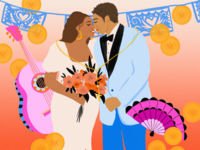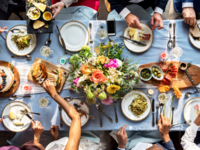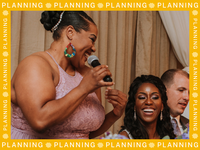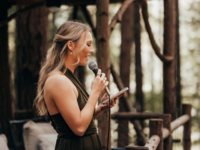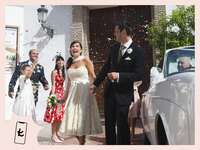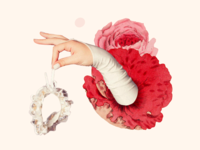Wedding Planners Give Us a Peak Inside El Salvador Wedding Traditions

While many people know El Salvador for its incredible coffee or numerous volcanoes, the densely-populated Central American nation's culture lends itself to vibrant, lively celebrations where family and faith take center stage. El Salvador wedding traditions include moments such as a unity ceremony involving a lasso, an exchange of gold coins and a "hora loca" at the reception where the party truly takes off.
To help bring these to life, many couples head to The Knot Vendor Marketplace to find wedding planners that will help their party go just as they want it to. While every culture has various unique wedding traditions, we spoke with wedding planners Paolo Hernandez and Mónica Sariles of Eventique, a five-star event planning team based in El Salvador to share with us what sets El Salvadorian weddings apart.
In this article: History | Prewedding | Attire | Ceremony | Reception | Food & Drink
A Brief History of El Salvadoran Wedding Traditions
Catholicism and a respect for family are at the heart of most El Salvadorian wedding traditions. Couples usually host weddings at a church and incorporate family members into all aspects of the ceremony and reception. This Catholic influence came to El Salvador when Spain invaded 1528 and made Catholicism the national religion, and the faith continued even after the country gained full independence in 1841.
During the one-hour wedding ceremony, guests will likely witness traditions such as the presentation of coins, known as arras, and the lasso ritual. Both of these traditions are deeply rooted in the nation's culture and history.
Prewedding El Salvadoran Traditions
When understanding wedding traditions in El Salvador, you need to start before the big day. Prewedding festivities, including getting engaged, are the couple's chance to begin incorporating their families into their engagement story and let them know their roles throughout the planning season and on the wedding day.
El Salvadorian Bridal Showers and Bach Parties
If the couple is having a Catholic wedding, there is usually a bridal shower given in honor of the Virgin Mary, which, according to Hernandez and Sariles, typically involves the couple's immediate family and close friends. "Each participant presents gifts with special meaning for establishing the home," they say. They highlighted that the most important gift is "an image of the Virgin Mary, symbolizing her intercession in the home." Sometimes, a second, non-religious bridal shower is also held in which only female friends and family members attend.
Around the same time, an El Salvadorian woman typically purchases her dress with her mother, sometimes including her to-be mother-in-law and maid of honor. Lastly, El Salvadorians host bachelorette and bachelor parties with their wedding parties before the wedding. This experience is very similar to the United States.
El Salvadorian Wedding Rehearsals
Hernandez and Sariles emphasized that during a wedding rehearsal, a couple and their wedding planners make sure to "explain when each person will have their part and the significance or importance of their role." By understanding their purpose in the wedding ceremony, each family member is honored, included and can practice their role.
Traditional El Salvadoran Wedding Attire
With the heavy Catholic and traditional influence in El Salvador, wedding attire is very similar to that in the United States and other Western nations. Brides usually wear a white dress and veil while grooms wear a black suit and tie. If the wedding is during the day and outside, Hernandez and Sariles share they may wear blue, beige or gray suits. The bridesmaids all wear a single color to compliment the groomsmen. Wedding guests should not wear white, beige, cream or any shade that comes close to the bride's dress.
El Salvadoran Wedding Ceremony Traditions
Most El Salvadorian weddings try to involve nearly every close family member in some way. Whether it is as ring bearers, flower girls, a reader or presenting arras and assisting in the lasso ceremony, everyone has a job during the wedding ceremony.
Bridal Party Duties
Among bridal parties, each person usually has a task. Hernandez and Sariles explain that among bridesmaids, one "can be in charge of the bride's bouquet, another in charge of positioning the dress and veil at all time, one in charge of attaching and fixing boutonnieres to the groom and groomsmen, and another in charge of handing out ceremony programs to the guests." It is an honor to be included in a bridal party, and by giving tasks such as these, everyone understands they play a critical part in the couple's lives.
Common Wedding Songs
The groom typically enters the wedding ceremony with his mother, commonly to the song, "Canon in D," which is one of many unique wedding ceremony entrances found around the globe. As the song continues, the bridal party, flower girls and ring bearers come in before the bride enters with her father, often to Mendelssohn's "Wedding March." When everyone exits, many couples choose to play Wagner's "Wedding March." Paolo and Sariles shared that guests often blow bubbles or wave ribbons as the newlyweds exit the church because most churches prohibit the use of rice and rose petals because it makes cleaning difficult or may stain the carpet.



Giving of the Arras
During the ceremony, the groom will present the bride with 13 coins, known as arras. Hernandez and Sariles emphasized how this "symbolizes the financial aspect of the new family" and the bride "simply receives them, as it is traditionally believed that the man is the provider for the family." However, they also wrote that "this tradition is evolving, and recently, the bride also gives arras to the groom, representing her contribution to the family's finances."
Commonly, family members or godparents provide the coins to the couple and are responsible for bringing them to the ceremony. The coins are usually made of gold and are often presented in a beautiful box or bag. While this is one of the many wedding ceremony traditions in El Salvador, it is common in neighboring nations as well.
Lasso Placement
Various cultures have so many different meaningful blessings and traditions, and the lasso ceremony certainly fits that bill. Practiced in many Hispanic cultures, this ritual occurs when family members drape the couple in a rope or similar item to symbolize the union of the new spouses. The lasso can be made of many things, be it an actual rope lasso, a rosary or an ornate cord. This choice depends on the couple's heritage, desires and customs.
Offering a Bouquet in a Catholic Ceremony
Hernandez and Sariles say that in most Catholic ceremonies in El Salvador, couples will place a bouquet by an image of the Virgin Mary in the church as an offering. This ritual is often seen to symbolize the hope that the bride will live a life similar to Mary's and gives the bride a moment to pray for Mary's guidance and strength in her marriage.
El Salvadoran Wedding Reception Traditions
Wedding receptions offer lots of space for a couple to celebrate their culture, something Hispanic and Latinx wedding vendors are passionate about. Here are a few traditional ways newlyweds celebrate their heritage during their party.
Cocktail Hour
Directly after the ceremony, wedding guests are usually invited to a cocktail hour with appetizers and drinks while the couple, bridal party and family take photos. During this time, serving beer is a must although most receptions also have wine, a special cocktail or even coconuts. Food typically includes ham and cheeses as well as sweet treats like sorbet, popsicles and small pastries.
A Typical El Salvadorian Wedding Reception
The wedding reception usually kicks off with the couple's introduction, immediately followed by their first dance, the bride's dance with her father and the groom's dance with his mother. Afterward, the father of the bride gives a toast. Hernandez and Sariles highlight that "this is customary because the bride's parents are the ones who typically pay for the wedding."
The main meal often involves a starter, a main course with meat and various side dishes. When dessert time rolls around, most El Salvadorian couples do not ceremoniously cut the cake. During this time, there is usually an open bar.
When the eating wraps up, almost all couples invite single women to participate in the bouquet toss and single men to try and catch the garter after the groom takes it off of his bride. After this, the party really gets going.
The Carnavalito or Hora Loca
A DJ or drum group, known as a batucada, now changes the music to liven up the party. Props "like necklaces, glasses and hats are given out to guests" while "the couple uses special props for themselves." The waitstaff will bring out tequila or cocktail shots, "sometimes on a lit-up cart to make the moment more striking." To add to the festivities, there are often special-themed characters like stilt walkers or LED robots to add some flair.
Traditional El Salvadoran Wedding Drinks and Snacks
Incredible food is central to wedding celebrations in cultures around the world, and El Salvador is no different. From pupusas and coconuts to popsicles and beer, there are a few things commonly seen at most wedding receptions.
El Salvadorian Drinks
The main drink expected at weddings in El Salvador is beer, although couples often have a signature cocktail or wine available. Many couples offer coconuts as a fun, non-alcoholic option, as well as popsicles for some much-needed hydration to keep the dancing going.
El Bajón: The Late Night Snack
For guests who have stuck around the reception for hours, the couple usually provides food like pupusas, hamburgers, tortilla soup or tacos to keep the energy up. This El Salvadoran wedding tradition often comes towards the end of the reception, which is at least six hours long. Eventually, the couple will head out on their honeymoon as the night wraps up.

